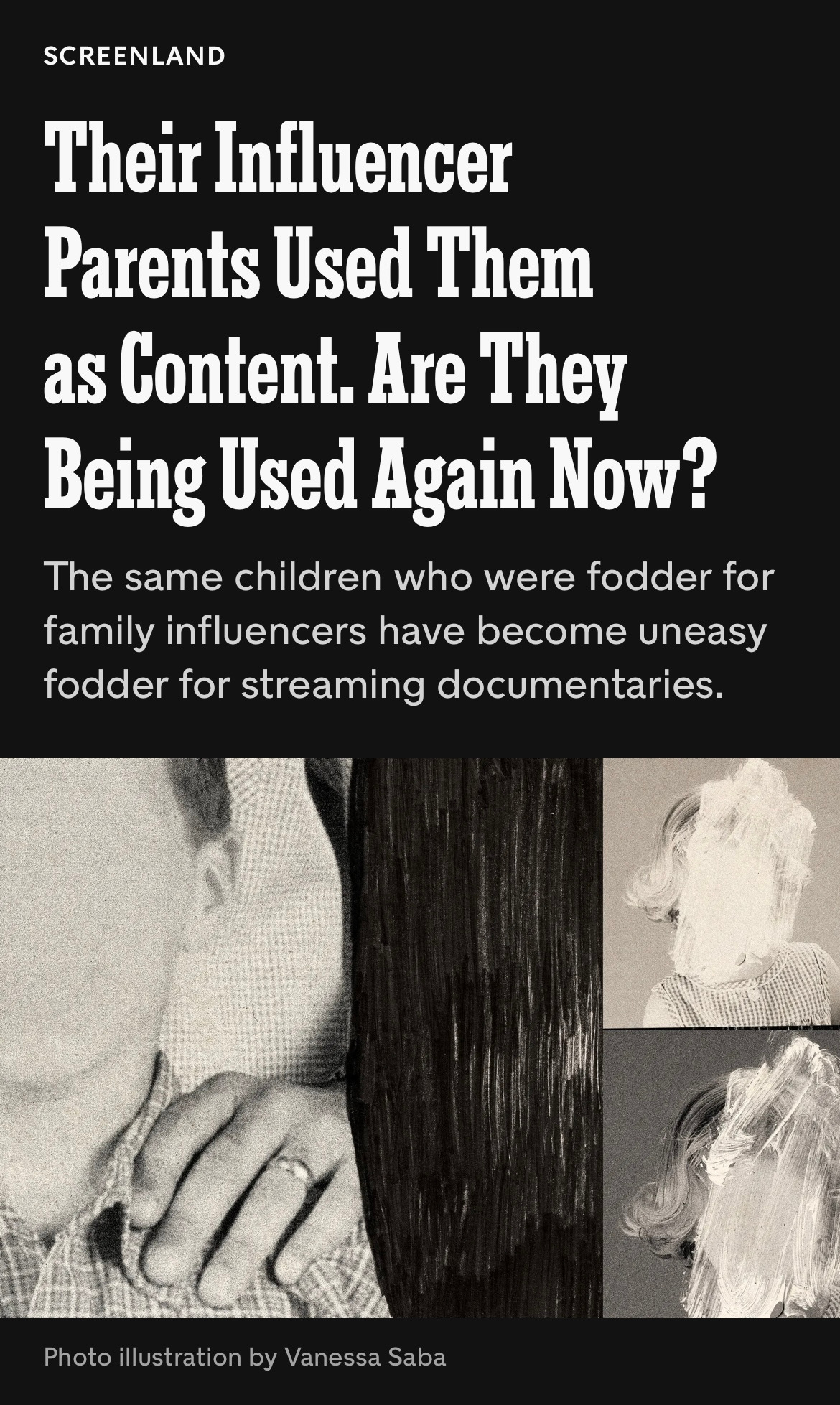Last week, for the New York Times Magazine’s Screenland column, I wrote about two documentaries that track the downfalls of family influencers: Hulu’s “Devil in the Family” about Ruby Franke, whose family YouTube channel once had two million subscribers before she was charged with aggravated child abuse in 2023, and HBO’s “An Update on Our Family” about Myka and James Stauffer, who grew a YouTube following by sharing their process of adopting a toddler from China in 2017, only to reveal in May 2020 that they had dissolved the adoption. In the essay (gift link here), I focus on a particular visual technique that both documentaries employ—they blur the faces of the very children whose lives were exploited for YouTube content and thus for money.
This piece had several origin points. I pitched it back in early February, after hearing about “An Update on Our Family” and the fact that the documentary blurs children’s faces in an interview with the director on the WNYC show “All of It.” That episode aired—and the documentary debuted—just before my book came out, so I wasn’t exactly in the position to drop everything and watch the show. But once I had a little breathing room at the end of January, I knew I had to tune in.
I had first heard of the Stauffers and the fact that they “unadopted” their transracially and transnationally adopted son Huxley back in summer 2020, from this excellent article by Caitlin Moscatello in The Cut. (“An Update on Our Family” credits Moscatello’s article—which also happens to mention the Frankes before their scandal—as source material.) And I had been drawn to that article in the first place because of my interest in how a particular subset of momfluencers—foster and adoptive momfluencers—capitalize on the vulnerable children in their care by sharing stories of their trauma.
In 2020, around the same time that I started working on the book proposal that would become The Sun Won’t Come Out Tomorrow, my Instagram explore page started serving me images of the children with their faces plastered over with a heart or their eyes scribbled out. When I clicked through on those censored faces, I realized that they were posted by foster moms who use stickers and scribbles to get around the prohibitions on sharing foster children’s images on the internet. I eventually wrote about this disturbing trend and how evangelical women in particular were exploiting foster children online in a December 2022 article for The Baffler. So when I heard that “An Update on Our Family” was similarly censoring the faces of children in service of an attempt to actually give back privacy to children whose parents stripped them of it by turning their lives into monetized content, I knew I would want to write about it.
After some back and forth with editor Nitsuh Abebe on how to broaden out the idea so it would be less focused on just “An Update on Our Family” and allow a grappling with the larger reckoning that is unfolding with family vlogging at the moment, we landed on including discussion of the Franke family. In the January, Shari Franke, daughter of convicted child abuser and former family vlogger Ruby, released a memoir about her experiences of growing up on YouTube and the exploitation abuse she suffered. It was an instant NYT best seller that provided a rare example of a former family vlogging kid actually speaking for themselves about their experience of having their childhood filmed for the public. Shari was also posting on Instagram about her support of a bill in Utah, her home state, that would protect the rights of children featured in online content, requiring that their parents set aside earnings for them in a trust and allowing children to request that content featuring them be removed from the internet when they turn 18.
Then, as the plan for the essay was firming up, a new documentary dropped—“Devil in the Family,” which focused on Ruby Franke’s path from wholesome Mormon mommy vlogger to abusive mother who believed her youngest children were possessed by Satan. Shari and Kevin, Ruby’s ex-husband, participated in the series, as did older Franke son Chad. And in the series, the four Franke children who are still minors all had their faces blurred.
There is so much more that I could have possibly written about these documentaries, the stories of the Franke and Stauffer families, and the ethical problems inherent in family influencing. But given the constraints of the column length and its mandate to focus on making sense of trends and tensions in our video-based visual culture, zeroing in on the attempt to excise children from footage already watched by millions provided plenty of material.
If I had more space, I would have of course wanted to write about how the Stauffers were spreading the gospel of adoption and painting an overly rosy picture of how “beautiful” transracial and transnational adoption is. I would have written about the fact that we do not have reliable statistics on how common adoption dissolution is, and how the federal government should track the outcomes of adoptions, something I touch on in The Sun Won’t Come Out Tomorrow. I would have dug further into the role the Franke’s Mormon faith and belief in the prosperity gospel played in their decision to invite the public into their family’s most intimate moments, and how the press sensationally covered the abuse Ruby Franke and her business partner perpetrated. I would have touched on how tabloids like People are now blurring the faces of the Franke kids in their prurient coverage of the doc, as though pixelation makes the continued exploitation of these kids fair game.
Still, I think my essay, which ran in the Sunday NYT Magazine in print yesterday, raises important questions about the ethical problems of making private family life public, and I hope you’ll read it.




